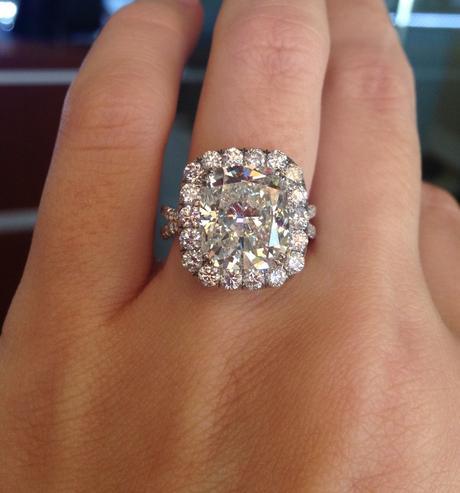The differences between GIA vs. EGL certified diamonds are hotly debated. A diamond certificate is a report card issued by a diamond grading lab. The diamond is evaluated on several different factors, including measurement/proportions, clarity, cut, color, polish, symmetry, brilliance and more.

What you see is what you get: GIA says this here’s a 6.01ct Cushion Cut Diamond, J in color and VS1 in clarity.
Many diamonds receive a certificate before they arrive at the retail point – your local jeweler. This assures you, the one shelling out the big bucks, that you’re getting what you pay for.
Diamond grading labs across the globe produce certificates. The authority of all of them though, is GIA (Gemological Institute of America.) The next best lab is EGL (European Gemological Laboratory.) It’s still regarded as a popular grader, but is distinct from GIA with one notable feature: its diamonds’ prices.
They’re typically lower than a GIA diamond with the “same” grade. Why? Well, EGL’s reputation precedes it. And in many circles, that reputation is inconsistent.
It’s not to say that EGL diamonds are worse (really, just because a diamond has a GIA certificate, doesn’t mean it’s better. It just means you are getting what you see.) However, EGL’s labs are far flung and their grades don’t necessarily match up. A stone graded in a USA EGL lab (sorry for all the acronyms) typically won’t get the same glowing report as it would at a more lenient EGL lab abroad. Whereas a GIA lab can be in Tokyo or Carlsbad and consistently give the same diamond grades.
Online diamond trading network (and diamond price list) RapNet recently and controversially banned EGL from its price lists.Beginning October 1, 2014, the marketplace no longer accepted EGL certified diamonds.
Martin Rapaport, chairman of The Rapaport Group, cited too much inconsistency in EGL reports, especially considering their inferiority to the “global standard of diamond grading set by [GIA.] The move was meant to increase transparency int eh diamond market and to eliminate some of the diamond inflating for which EGL International is notorious.
The move understandably upset EGL USA, which maintains stricter grading standards than their cousins across the globe.
So, the main difference between GIA vs. EGL diamonds, while on its face appears to be price, is not. It’s not even the underlying issue of EGL’s relative inconsistency. It’s that one sets the industry standard and the other engages in questionable fluffing up of diamonds’ characteristics.
The main difference, then, is trust.
Without the customer protection & satisfaction of the GIA stamp of approval, a diamond shopper is at the mercy of whichever EGL International lab got its loupe on that stone. Hopefully they were scrupulous in grading that rock a VS1 clarity, but anyone who’s spent time diamond shopping will tell you that they’ve seen some questionable grades.
That being said, EGL USA has a right to be upset about the Rap ban. Their diamonds are for the most part par for the course with GIA’s edicts. All diamond grading is done by Graduate Gemologists, to the field is always open to marginal varying of opinions, but EGL USA’s diamonds don’t vary that wildly from the GIA definitions.
Except, of course, when it comes to price. A GIA diamond will always be a hair more than an EGL, which will warrant a price bump over an uncertified diamond of the same quality and size. The labs, while doing a great service to the diamond industry and our customers, are still businesses with brands to maintain. And their stamp of approval = a brand name. So you will pay more for them. And when it comes to GIA vs. EGL diamonds it’s easy to explain them as two brands very close in competition, quality and product, but with one just a tad more desirable.

